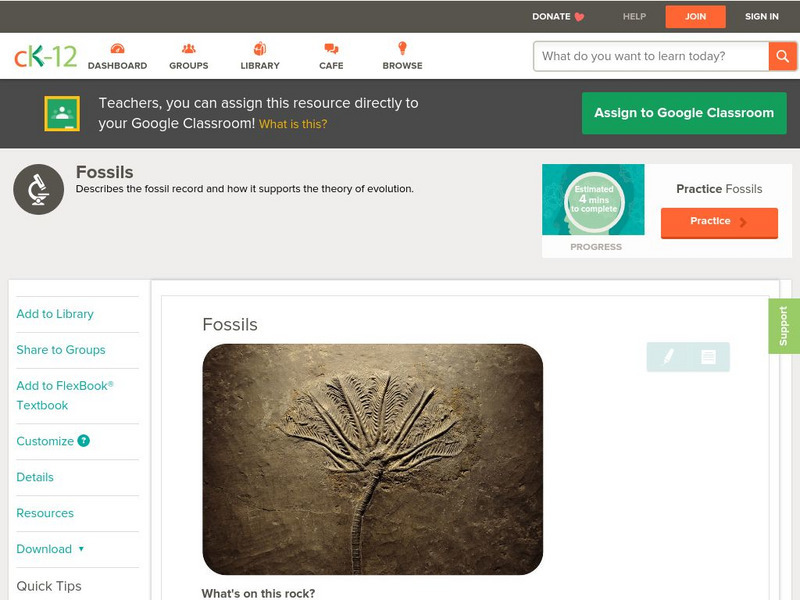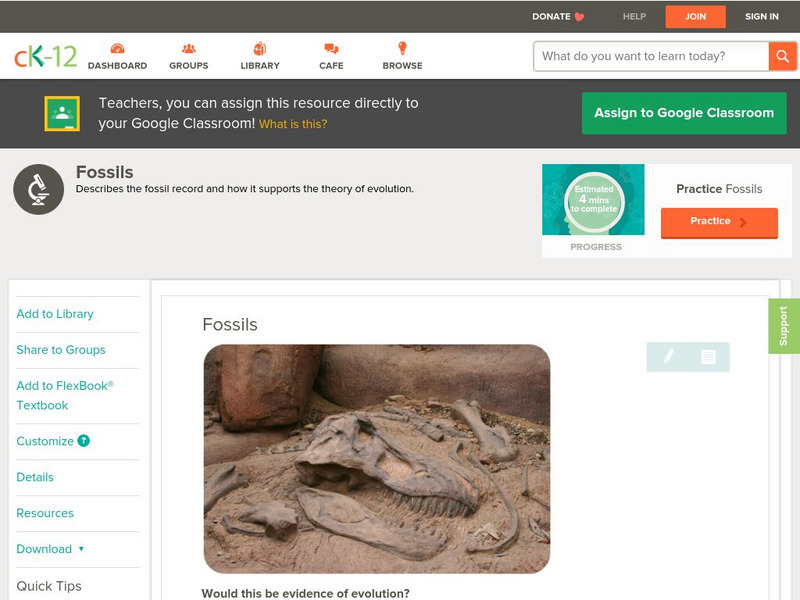Hi, what do you want to do?
Smithsonian Institution
National Museum of Natural History: Paleobiology: Geologic Time: The Oligocene
Travel through Earth's history to learn about the Oligocene time period, which is characterized by the appearance of most of the living families of mammals.
John Wiley & Sons
Wiley: Earth Through Time: Life of the Paleozoic: Phylum Chordata
Learn about the evolution of life in the Paleozoic Era based on fossil evidence of the five classes of fishes. Read about the role these chordates played in the evolution of tetrapods.
Wonderville Media
Wonderville: Charles Darwin
Charles Darwin was born in England on February 12, 1809. He was a "naturalist," best known for his theories of evolution. Darwin collected evidence that all life on Earth "evolved" from a common ancestry. He studied the process of...
CK-12 Foundation
Ck 12: Life Science: Fossils
[Free Registration/Login may be required to access all resource tools.] Fossils are the preserved remains of animals, plants, and other organisms from the distant past. By studying fossils, evidence for evolution is revealed....
PBS
Pbs: Comparative Embryology: The Vertebrate Body
Provides a student handout in PDF format that looks at the developmental stages of five vertebrate organisms from fertilization to adult form. Students can look at the pictures to see the similarities and differences at the embryo stage...
CK-12 Foundation
Ck 12: Biology: Fossils
[Free Registration/Login may be required to access all resource tools.] Describes how fossils help us understand the past.
Open Curriculum
Open Curriculum: Studying the History of Life
This in-depth article illustrates the concept of geologic time, and helps the learner understand why fossils are rare.
CPALMS
Cpalms: Name That Embryo
In this lesson, students will look at images of embryos from different organisms and identify similarities and differences between them to indicate possible evolutionary relationships. Includes PowerPoint and student handouts.
Khan Academy
Khan Academy: Molecular Genetics Unit Test
Take this nine-question unit test over molecular genetics.
Curated OER
Smithsonian Nmnh: What Does It Mean to Be Human, Human Evolution Evidence
What does it mean to become human? This brilliant and detailed resource examines early man's behavior, including information on stone tools he used, burial, clothing, and shelter. Find information on genetics including human skin color...
CK-12 Foundation
Ck 12: Biology: Fossils
[Free Registration/Login may be required to access all resource tools.] Describes how fossils help us understand the past.
Curated OER
Unesco: Spain: Teide National Park
Situated on the island of Tenerife, Teide National Park features the Teide-Pico Viejo stratovolcano that, at 3,718 m, is the highest peak on Spanish soil. Rising 7,500 m above the ocean floor, it is regarded as the world’s third-tallest...
Curated OER
Unesco: Indonesia: Lorentz National Park
Lorentz National Park (2.35 million ha) is the largest protected area in South-East Asia. It is the only protected area in the world to incorporate a continuous, intact transect from snowcap to tropical marine environment, including...
Curated OER
Unesco: Ethiopia: Lower Valley of the Awash
The Awash valley contains one of the most important groupings of palaeontological sites on the African continent. The remains found at the site, the oldest of which date back at least 4 million years, provide evidence of human evolution...
Curated OER
Unesco: Tanzania: Ngorongoro Conservation Area
The Ngorongoro Conservation Area spans vast expanses of highland plains, savanna, savanna woodlands and forests. Established in 1959 as a multiple land use area, with wildlife coexisting with semi-nomadic Maasai pastoralists practicing...
Curated OER
Unesco: Thailand: Ban Chiang Archaeological Site
Ban Chiang is considered the most important prehistoric settlement so far discovered in South-East Asia. It marks an important stage in human cultural, social and technological evolution. The site presents the earliest evidence of...
Other popular searches
- Dna Evidence for Evolution
- Fossil Evidence of Evolution
- Evidence for Evolution Whale
- Evolution Evidence
- Fossil Evidence Evolution













